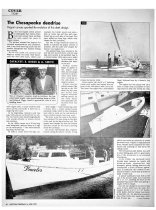Archive Record
Images

Metadata
Title |
"The Chesapeake deadrise - Dugout canoes sparked the evolution of this sleek design," |
Collection |
National Fisherman Articles by Larry Chowning |
Catalog Number |
2020.9.2.186 |
Date |
JUNE, 1999 |
Scope & Content |
NATIONAL FISHERMAN, JUNE, 1999, Pg. 40 COVER STORY "The Chesapeake deadrise - Dugout canoes sparked the evolution of this sleek design. By Larry Chowning By the time English settlers arrived on Chesapeake Bay, Native Amer- icans had already been working the area waters for years in dugout canoes. The settlers adapted the dugouts for personal transportation and commerce, and it was from these log canoes that the modern Chesapeake Bay deadrise fishing boat evolved. By the late 1600s, the colonists had begun to modify the canoe. They discov- ered that with their saws, chisels and other edged tools, a canoe could be built more quickly and easily if more than a single log were used. In the beginning, colonists used two logs, hollowing out each half with an adz. The two halves were joined longitudinally with wooden dowels, or tenons, driven into mortises. By the 1900s, canoes up to 50 feet long were being built, using as many as 11 logs in the construction — the odd-numbered log being the keel log. To build a canoe with five logs, for example, the builder would start with a keel, or center, log, and then add a gar- board log on each side of the keel. Last were added two wing logs, which were chosen for their curvature. The sets of logs would be raised on blocks to maintain the proper amount of deadrise. After the sides were shaped, the interior was roughed out. The garboard logs were secured to the keel log with iron-drift bolts, and the wing logs were secured to the garboard logs in a similar fashion. Filler pieces were added to give shape to the sheerline and depth to the hull. Sailing canoes began to appear in the region after 1850, but the design endured for generations, with fishermen standing on the side decks to tong for oysters. Single-masted sailing canoes (like the one in the 1919 photo) for the most part hailed from Virginia. Maryland sailing canoes, on the other hand, were generally con structed with two masts. Their weight — some bottom logs were 7 inches thick — made sailing canoes extremely stable, which is why watermen were able to stand on the side decks of these relatively slender boats and work. The mast, as on the canoe in the photo, was unstayed. The pole lying on the deck is the sprit for the leg-of-mutton sail. The oysters were brought up from the bottom and then sorted on the board running across the coamings. All across Chesapeake Bay, engines started taking the place of sails in log canoes. Some canoes, like the 38’ x 6’ three-log canoe with cuddy and engine box pic- tured in the 1940 photo, never had a sail. This boat's first engine was a one-cylinder Regal, followed later by a Model-A Ford engine. The engine box was placed well aft to leave as much room as possible for mov- ing around on deck and storing the catch, which was made up primarily of oysters harvested from Virginia’s Rappahannock River. Wooden knees supported the wash- boards and coamings as they did in the sailing canoes. The forward-mounted shelter was used to store fishing gear and is a good exam- ple of the transition to an enclosed wheelhouse. In the 1940s, the enclosed house became more common on vessels, and plank-on-frame construction was accepted, giving fishing boats on the Chesapeake a much different appear- ance. In particular, this method of con- struction made it much more practical to build a wider boat. A typical waterman’s boat built at the end of the decade might have measured 40’ x 12’ x 3’, doubling the beam of the motorized log canoe while only gaining a couple of feet in length. Not a lot has changed in the intervening years. In fact, aside from the wider, flatter transom, the 42’ x 12’ 6" x 2‘ 10" Traveler (1992 photo), built by Glover Lee Owens of Deltaville, Va., for Maryland waterman John Orme, looks very much like a boat built 50 years ago. |
Source |
Chowning, Larry |
